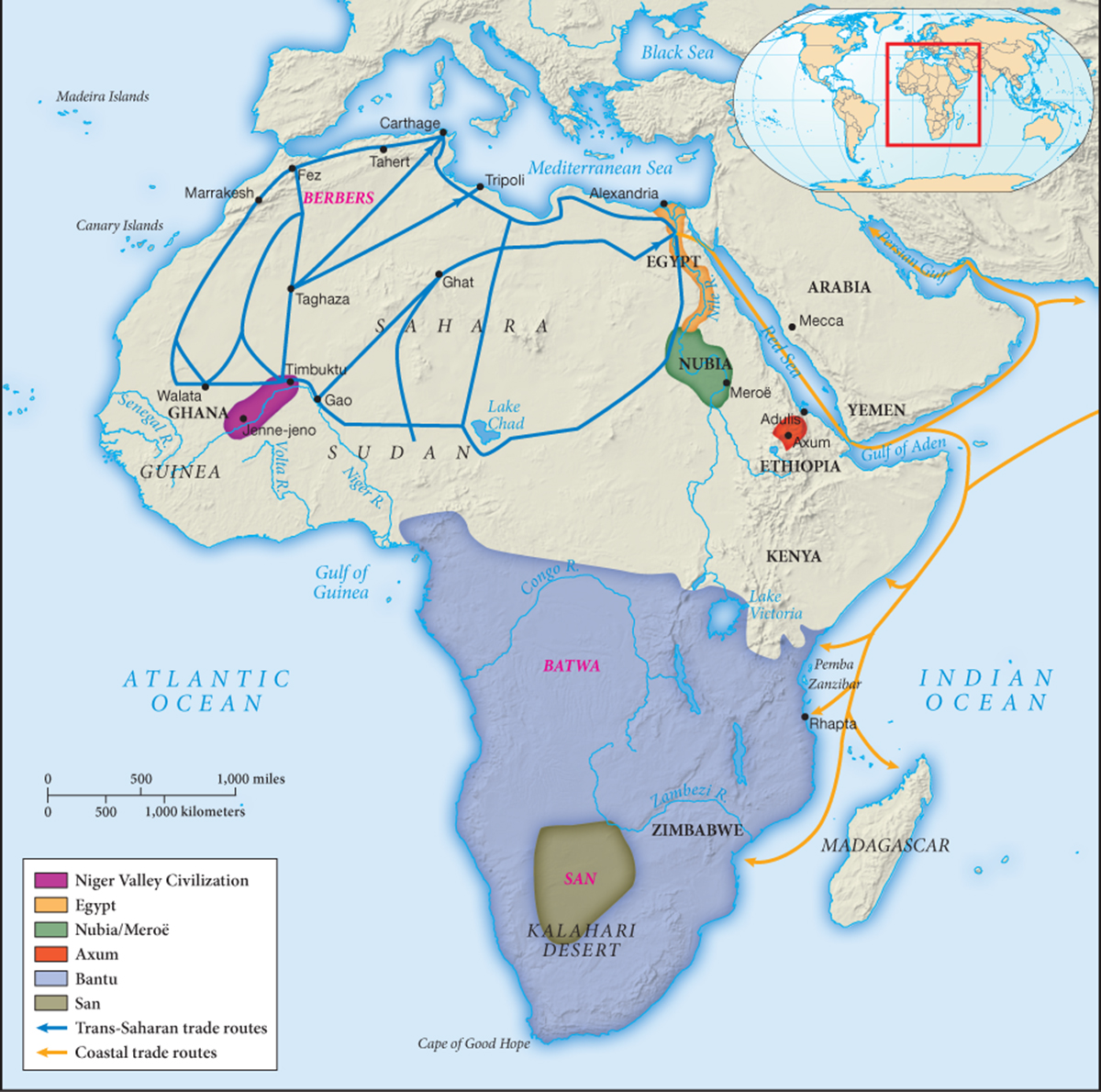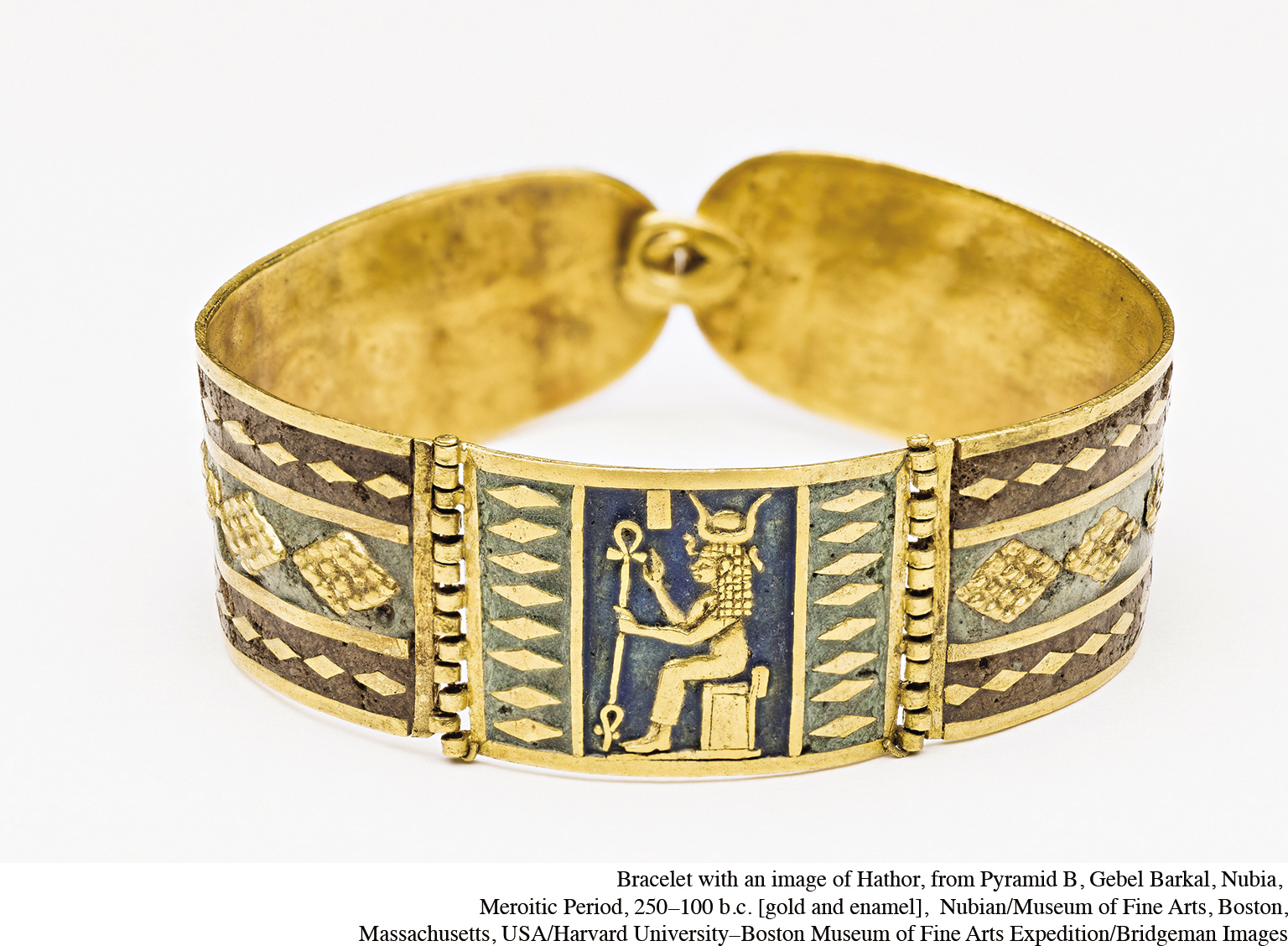Meroë: Continuing a Nile Valley Civilization
In the Nile Valley south of Egypt lay the lands of Nubian civilization, almost as old as Egypt itself. Over many centuries, Nubians both traded and fought with Egypt, and on one occasion the Nubian Kingdom of Kush conquered Egypt and ruled it for a century. (See Zooming In: Piye.) While borrowing heavily from Egypt, Nubia remained a distinct and separate civilization. As Egypt fell increasingly under foreign control, Nubian civilization came to center on the southern city of Meroë (MER-oh-ee), where it flourished between 300 B.C.E. and 100 C.E. (see Map 6.1).

Map 6.1 Africa in the Second-Wave Era During the second-wave era, older African civilizations such as Egypt and Nubia persisted and changed, while new civilizations emerged in Axum and the Niger River valley. South of the equator, the process of Bantu expansion created many new societies and identities.
How did the history of Meroë and Axum reflect interaction with neighboring civilizations?

A Bracelet from Meroë This gold bracelet, dating to about 100 B.C.E., illustrates the skill of Meroë’s craftsmen as well as the kingdom’s reputation as one of the wealthiest states of the ancient world. The bracelet’s depiction of a seated Hathor, a popular Egyptian goddess, shows the influence of Egyptian culture in Nubia. (Bracelet with an image of Hathor, from Pyramid B, Gebel Barkal, Nubia, Meroitic Period, 250–100 B.C. [gold and enamel], Nubian/Museum of Fine Arts, Boston, Massachusetts, USA/Harvard University–Boston Museum of Fine Arts Expedition/Bridgeman Images)
Politically, the Kingdom of Meroë was governed by an all-powerful and sacred monarch, a position held on at least ten occasions by women, governing alone or as co-rulers with a male monarch. Unlike the female pharaoh Hatshepsut in Egypt, who was portrayed in male clothing, Meroë queens appeared in sculptures as women and with a prominence and power equivalent to their male counterparts. In accordance with ancient traditions, such rulers were buried along with a number of human sacrificial victims. The city of Meroë and other urban centers housed a wide variety of economic specialties—merchants, weavers, potters, and masons, as well as servants, laborers, and slaves. The smelting of iron and the manufacture of iron tools and weapons were especially prominent industries. The rural areas surrounding Meroë were populated by peoples who practiced some combination of herding and farming and paid periodic tribute to the ruler. Rainfall-based agriculture was possible in Meroë, and consequently farmers were less dependent on irrigation. This meant that the rural population did not need to concentrate so heavily near the Nile as was the case in Egypt.
The wealth and military power of Meroë derived in part from extensive long-distance trading connections, to the north via the Nile and to the east and west by means of camel caravans. Its iron weapons and cotton cloth, as well as its access to gold, ivory, tortoiseshells, and ostrich feathers, gave Meroë a reputation for great riches in the world of northeastern Africa and the Mediterranean. The discovery in Meroë of a statue of the Roman emperor Augustus, probably seized during a raid on Roman Egypt, testifies to contact with the Mediterranean world. Culturally, Meroë seemed to move away from the heavy Egyptian influence of earlier times. A local lion god, Apedemek, grew more prominent than Egyptian deities such as Isis and Osiris, while the use of Egyptian-style writing declined as a new and still-undeciphered Meroitic script took its place.
In the centuries following 100 C.E., the Kingdom of Meroë declined, in part because of deforestation caused by the need for wood to make charcoal for smelting iron. Furthermore, as Egyptian trade with the African interior switched from the Nile Valley route to the Red Sea, the resources available to Meroë’s rulers diminished and the state weakened. The effective end of the Meroë phase of Nubian civilization came with the kingdom’s conquest in the 340s C.E. by the neighboring and rising state of Axum. In the centuries that followed, three separate Nubian states emerged, and Coptic (Egyptian) Christianity penetrated the region. For almost a thousand years, Nubia was a Christian civilization, using Greek as a liturgical language and constructing churches in Coptic or Byzantine fashion. After 1300 or so, political division, Arab immigration, and the penetration of Islam eroded this Christian civilization, and Nubia became part of the growing world of Islam (see Chapter 10).

